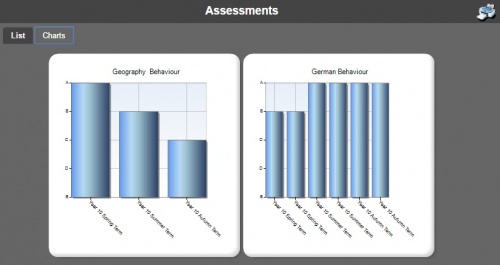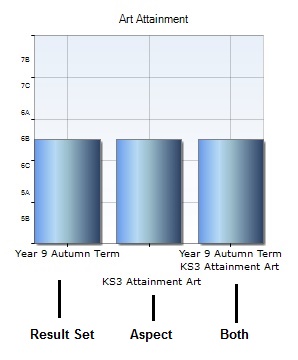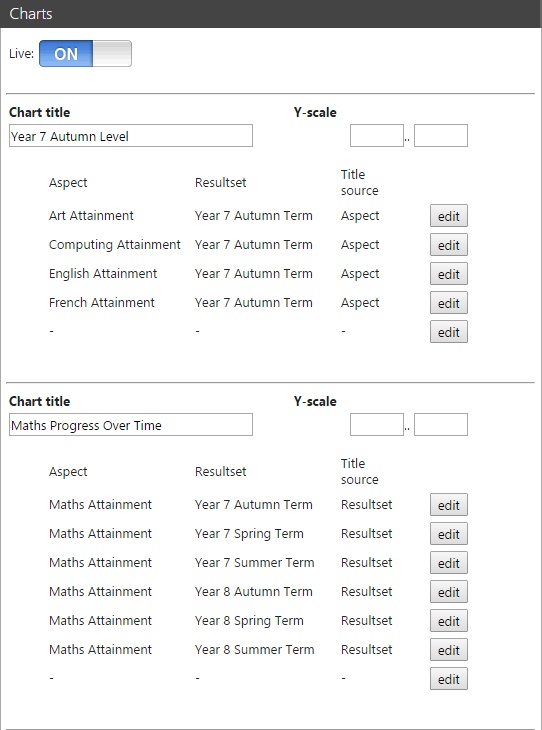Difference between revisions of "AM charts"
| Line 1: | Line 1: | ||
__FORCETOC__ | __FORCETOC__ | ||
| − | + | The AM charts page is used to configure bar charts that appear on the [[assessments]] page (users will need the "Show progress charts" [[role options|role option]] enabled to see the charts). The charts can either be configured via the AM charts page, or by editing a text file on the IIS server that hosts Insight. <br> <br> | |
| − | + | In order for charts to be displayed, grades must be collected from SIMS rather than [[TASC Software Community Portal|PARS]]. The setting for this is found via [[Preferences]] > PARS > Collect grades from PARS (this is only applicable to schools using PARS). <br> <br> | |
| − | + | [[Image:amchartexample.jpg|500px]] <br> <br> | |
| − | = | + | =Using the AM charts page= |
| − | + | At the top of the page there is a "Live" option. This must be switched on in order for charts to be displayed to users. The rest of the page is used to configure the charts. <br> <br> | |
| − | + | Each chart needs to be given a title. There is an edit button which opens a window to add a column to the chart. In the window there are options to select an Aspect and Result Set, from which the data will be taken. There is also a "Column title source" option used to label the column, which can be set to either Aspect, Result Set or Both. <br> <br> | |
| − | [[Image: | + | [[Image:am_charts_labels.jpg|frame|left|The output from each Column title source setting]] <br> <br> <br> <br> <br> <br> <br> <br> <br> <br> <br> <br> <br> <br> <br> <br> <br> <br> <br> <br> <br> <br> |
| − | + | Each chart will need one or more columns added to it in order for it to be displayed to users. Multiple charts can be created and will look similar to the following: <br> <br> | |
| − | + | [[Image:am_charts.jpg]] <br> <br> | |
| − | + | =Using the text file on the IIS server= | |
| − | |||
| − | + | There is a file on the server that hosts Insight which can be used to create the AM charts. The file is found in the _Personalisation folder, which is typically C:\wwwroot\inetput\INSIGHT\_Personalisation. The file will either be called assessments.charts or assessments.charts.unused <br> <br> | |
| − | + | If you have a file called assessments.charts then open that file using Notepad or a similar basic text editor (not Microsoft Word!). If you do not have an assessment.charts file but do have an assessments.charts.unused file, then edit the assessments.chart.unused file, remove the .unused extension, then edit the file using Notepad or similar basic text editor. If you do not have either file, run an [[service pack|Insight service pack]]. <br> <br> | |
| − | |||
| − | |||
| − | |||
| − | + | The first line of the file must always read: | |
| − | + | <pre> | |
| − | + | <root> | |
| − | + | </pre> <br> | |
| − | |||
| − | |||
| − | |||
| − | |||
| − | |||
| − | |||
| − | |||
| − | |||
| − | |||
| + | Following that, a new chart can be created by adding the following line of text: | ||
<pre> | <pre> | ||
| − | <chart id=" | + | <chart id="ENTER TITLE HERE" /> |
| − | |||
| − | |||
| − | |||
| − | |||
| − | |||
| − | |||
| − | |||
| − | |||
| − | |||
| − | |||
| − | |||
</pre> | </pre> | ||
| + | Where ENTER TITLE HERE is replaced by the title for the chart. <br> <br> | ||
| − | + | Columns are then added using the following line of text, repeated for each column on the chart: | |
| − | |||
| − | |||
| − | |||
| − | |||
| − | |||
| − | |||
| − | |||
| − | |||
| − | |||
<pre> | <pre> | ||
| − | + | <aspect chart="ENTER TITLE HERE" aspect="ENTER ASPECT NAME" resultset="ENTER RESULT SET NAME" xlabel="ENTER LABEL" /> | |
| − | |||
| − | |||
| − | |||
</pre> | </pre> | ||
| + | The name of the chart, the Aspect and the Result Set must be entered into the relevant sections. If the aspect is not associated with a Result Set, no text should be entered into the resultset option. The xlabel option can be set to: <br> | ||
| + | a - for the name of the Aspect <br> | ||
| + | r - for the name of the Result Set <br> | ||
| + | ra - for the name of the Aspect and Result Set <br> <br> | ||
| − | + | The lines above can be repeated to create multiple charts and columns. The final line of text must read: | |
| + | <pre> | ||
| + | </root> | ||
| + | </pre> <br> | ||
| − | + | This example represents a chart showing nine samples of a single aspect over Key Stage 3. | |
| + | <pre> | ||
| + | <chart id="KS3 Science Level" /> | ||
| + | <aspect chart="KS3 Science Level" aspect="Science Attainment Level" resultset="Year 7 Autumn Term" xlabel="r" /> | ||
| + | <aspect chart="KS3 Science Level" aspect="Science Attainment Level" resultset="Year 7 Spring Term" xlabel="r"/> | ||
| + | <aspect chart="KS3 Science Level" aspect="Science Attainment Level" resultset="Year 7 Summer Term" xlabel="r"/> | ||
| + | |||
| + | <aspect chart="KS3 Science Level" aspect="Science Attainment Level" resultset="Year 8 Autumn Term" xlabel="r"/> | ||
| + | <aspect chart="KS3 Science Level" aspect="Science Attainment Level" resultset="Year 8 Summer Term" xlabel="r"/> | ||
| + | <aspect chart="KS3 Science Level" aspect="Science Attainment Level" resultset="Year 8 Spring Term" xlabel="r"/> | ||
| + | |||
| + | <aspect chart="KS3 Science Level" aspect="Science Attainment Level" resultset="Year 9 Autumn Term" xlabel="r"/> | ||
| + | <aspect chart="KS3 Science Level" aspect="Science Attainment Level" resultset="Year 9 Spring Term" xlabel="r"/> | ||
| + | <aspect chart="KS3 Science Level" aspect="Science Attainment Level" resultset="Year 9 Summer Term" xlabel="r"/> | ||
| + | </pre> <br> | ||
| + | This example shows different Aspects sampled from the same Result Set: | ||
<pre> | <pre> | ||
| − | <chart id=" | + | <chart id="GCSE Targets" /> |
| − | <aspect chart=" | + | <aspect chart="GCSE Targets" aspect="GCSE Art Target" resultset="Year 10 Target" xlabel="a"/> |
| − | <aspect chart=" | + | <aspect chart="GCSE Targets" aspect="GCSE Biology Target" resultset="Year 10 Target" xlabel="a"/> |
| − | <aspect chart=" | + | <aspect chart="GCSE Targets" aspect="GCSE Chemistry Target" resultset="Year 10 Target" xlabel="a"/> |
| + | <aspect chart="GCSE Targets" aspect="GCSE Computing Target" resultset="Year 10 Target" xlabel="a"/> | ||
| + | <aspect chart="GCSE Targets" aspect="GCSE Dance Target" resultset="Year 10 Target" xlabel="a"/> | ||
| + | <aspect chart="GCSE Targets" aspect="GCSE Drama Target" resultset="Year 10 Target" xlabel="a"/> | ||
| + | <aspect chart="GCSE Targets" aspect="GCSE English Target" resultset="Year 10 Target" xlabel="a"/> | ||
</pre> | </pre> | ||
| − | |||
| − | |||
| − | |||
| − | |||
| − | |||
| − | |||
[[Category:Configuration]] | [[Category:Configuration]] | ||
| + | [[Category:Technical]] | ||
Revision as of 11:33, 9 December 2015
The AM charts page is used to configure bar charts that appear on the assessments page (users will need the "Show progress charts" role option enabled to see the charts). The charts can either be configured via the AM charts page, or by editing a text file on the IIS server that hosts Insight.
In order for charts to be displayed, grades must be collected from SIMS rather than PARS. The setting for this is found via Preferences > PARS > Collect grades from PARS (this is only applicable to schools using PARS).
Using the AM charts page
At the top of the page there is a "Live" option. This must be switched on in order for charts to be displayed to users. The rest of the page is used to configure the charts.
Each chart needs to be given a title. There is an edit button which opens a window to add a column to the chart. In the window there are options to select an Aspect and Result Set, from which the data will be taken. There is also a "Column title source" option used to label the column, which can be set to either Aspect, Result Set or Both.
Each chart will need one or more columns added to it in order for it to be displayed to users. Multiple charts can be created and will look similar to the following:
Using the text file on the IIS server
There is a file on the server that hosts Insight which can be used to create the AM charts. The file is found in the _Personalisation folder, which is typically C:\wwwroot\inetput\INSIGHT\_Personalisation. The file will either be called assessments.charts or assessments.charts.unused
If you have a file called assessments.charts then open that file using Notepad or a similar basic text editor (not Microsoft Word!). If you do not have an assessment.charts file but do have an assessments.charts.unused file, then edit the assessments.chart.unused file, remove the .unused extension, then edit the file using Notepad or similar basic text editor. If you do not have either file, run an Insight service pack.
The first line of the file must always read:
<root>
Following that, a new chart can be created by adding the following line of text:
<chart id="ENTER TITLE HERE" />
Where ENTER TITLE HERE is replaced by the title for the chart.
Columns are then added using the following line of text, repeated for each column on the chart:
<aspect chart="ENTER TITLE HERE" aspect="ENTER ASPECT NAME" resultset="ENTER RESULT SET NAME" xlabel="ENTER LABEL" />
The name of the chart, the Aspect and the Result Set must be entered into the relevant sections. If the aspect is not associated with a Result Set, no text should be entered into the resultset option. The xlabel option can be set to:
a - for the name of the Aspect
r - for the name of the Result Set
ra - for the name of the Aspect and Result Set
The lines above can be repeated to create multiple charts and columns. The final line of text must read:
</root>
This example represents a chart showing nine samples of a single aspect over Key Stage 3.
<chart id="KS3 Science Level" /> <aspect chart="KS3 Science Level" aspect="Science Attainment Level" resultset="Year 7 Autumn Term" xlabel="r" /> <aspect chart="KS3 Science Level" aspect="Science Attainment Level" resultset="Year 7 Spring Term" xlabel="r"/> <aspect chart="KS3 Science Level" aspect="Science Attainment Level" resultset="Year 7 Summer Term" xlabel="r"/> <aspect chart="KS3 Science Level" aspect="Science Attainment Level" resultset="Year 8 Autumn Term" xlabel="r"/> <aspect chart="KS3 Science Level" aspect="Science Attainment Level" resultset="Year 8 Summer Term" xlabel="r"/> <aspect chart="KS3 Science Level" aspect="Science Attainment Level" resultset="Year 8 Spring Term" xlabel="r"/> <aspect chart="KS3 Science Level" aspect="Science Attainment Level" resultset="Year 9 Autumn Term" xlabel="r"/> <aspect chart="KS3 Science Level" aspect="Science Attainment Level" resultset="Year 9 Spring Term" xlabel="r"/> <aspect chart="KS3 Science Level" aspect="Science Attainment Level" resultset="Year 9 Summer Term" xlabel="r"/>
This example shows different Aspects sampled from the same Result Set:
<chart id="GCSE Targets" /> <aspect chart="GCSE Targets" aspect="GCSE Art Target" resultset="Year 10 Target" xlabel="a"/> <aspect chart="GCSE Targets" aspect="GCSE Biology Target" resultset="Year 10 Target" xlabel="a"/> <aspect chart="GCSE Targets" aspect="GCSE Chemistry Target" resultset="Year 10 Target" xlabel="a"/> <aspect chart="GCSE Targets" aspect="GCSE Computing Target" resultset="Year 10 Target" xlabel="a"/> <aspect chart="GCSE Targets" aspect="GCSE Dance Target" resultset="Year 10 Target" xlabel="a"/> <aspect chart="GCSE Targets" aspect="GCSE Drama Target" resultset="Year 10 Target" xlabel="a"/> <aspect chart="GCSE Targets" aspect="GCSE English Target" resultset="Year 10 Target" xlabel="a"/>


